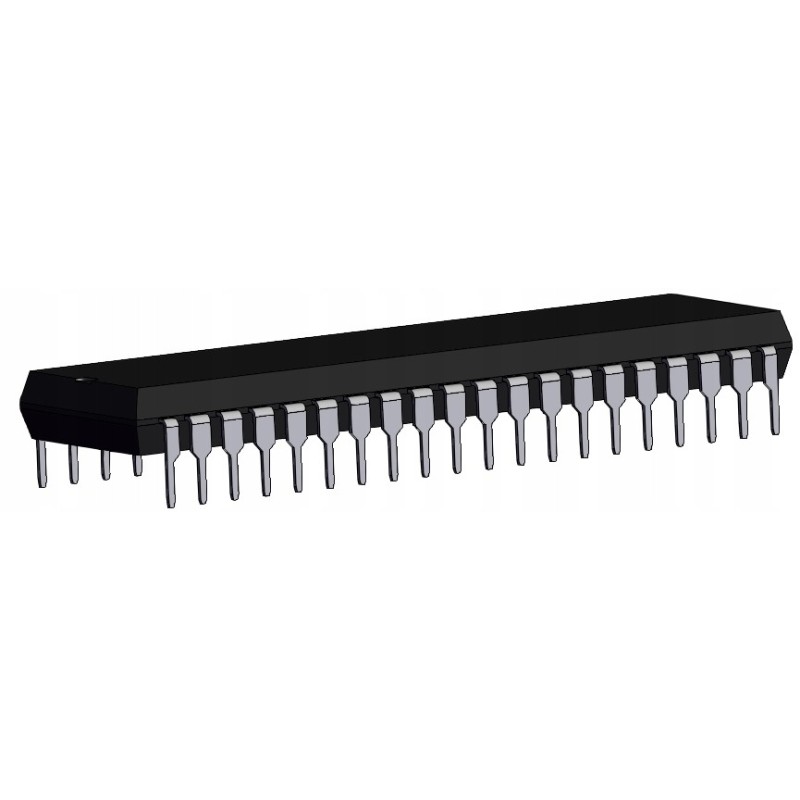- Out-of-Stock







Z84C0006PEC processor
Chips bear traces of soldering, legs are full length. Real photographs
The Z84C0006PEC processor is a variant of the Z80 microprocessor clocked at 6 MHz. It is a classic 8-bit processor, widely used in embedded systems and personal computers in the 1980s and today in retrocomputing applications and industrial control systems. It is distinguished by its simple but powerful architecture, which was innovative at the time of its release and is still used today for its flexibility and low power requirements.
Technical characteristics of the Z84C0006PEC processor:
Architecture and registers:
The Z80 processor is an 8-bit CPU that can process data in 8-bit words, but also supports operations on 16-bit data. It has a set of 14 general purpose registers that can be used to store data and addresses. These are registers B, C, D, E, H, L and their 16-bit pairs, such as BC, DE, H In addition, the Z80 has two sets of registers: a main register and an alternate register. These registers can be quickly switched between each other, speeding up the handling of interrupts and complex operations. The special registers include: accumulator (A), flag register (F), index registers IX and IY, stack register SP, and program counter (PC).
Clock and timing:
The maximum clock frequency of the Z84C0006PEC is 6 MHz, allowing the processor to execute up to 6 million clock cycles per second. Each instruction requires between 4 and 13 clock cycles, which in practice translates into a performance of approximately 0.5-2 MIPS (million instructions per second), depending on the complexity of the operation.
Instruction set:
The processor supports an extensive CISC instruction set that includes approximately 158 basic instructions, plus additional extensions for 16-bit special mode data operations. Instructions include arithmetic operations, logic operations, bit shifts, program flow control (conditional and unconditional jumps), and stack operations. Unlike earlier processors, the Z80 offers more advanced addressing modes, such as indirect addressing through index registers (IX, IY) and relative addressing.
Interrupt system:
The Z80 supports three interrupt modes: IM 0, IM 1 and IM 2.
The processor also has a dedicated non-maskable interrupt (NMI), which is always handled, regardless of the state of the interrupt flags.
Addressing modes:
The Z80 processor supports various addressing modes, such as:
Memory and peripheral support:
The Z80 has built-in input/output (I/O) ports for direct communication with external devices. Each I/O port is addressed with an 8-bit address, allowing support for up to 256 peripherals. The processor supports an 8-bit data bus and a 16-bit address bus, allowing the full 64 KB of memory space to be addressed. Special IN and OUT instructions are provided for communication with peripherals via the I/O bus.
Performance and applications:
The processor features low power consumption, making it ideal for embedded systems, mobile devices and applications requiring energy efficiency. Due to its simplicity of implementation and low cost, the Z84C0006PEC is used in a wide range of applications such as industrial controllers, embedded control systems, and retrocomputers (e.g. ZX Spectrum, Amstrad CPC).
Housing and assembly:
The Z84C0006PEC processor is available in a DIP-40 (Dual In-line Package) chassis with 40 leads, which facilitates its integration into classic PCB layouts and prototype systems.
The product was placed on the market within the EU before December 13, 2024.
Swallowing Hazard – Small fastening components, such as screws, nuts, or washers, can pose a choking or swallowing hazard, especially for children. They should be stored in a place out of reach of children.
Spreading of Small Components – These components can pose a tripping or loss hazard during work. They should be stored in containers that prevent spillage.
| Manufacturer (Private Label) (EU) 2023/988 (GPSR) | |
|---|---|
| Name: | Superelektronika sp. z o.o. |
| Address: | ul. gen. K. Sosnkowskiego 26/83 05-300 Mińsk Mazowiecki, Poland |
| E-mail: | sklep@superelektronika.pl |
| Responsible Person (EU) 2023/988 (GPSR) | |
| Full Name: | Radosław Jaromin |
| Address: | Arynów 46A 05-300 Mińsk Mazowiecki, Poland |
| E-mail: | radoslaw.jaromin@gmail.com |



